Native to regions of The Americas, Europe, Asia, and North Africa, orange beetles stand out with their vivid colors.
Orange is the color of toxins and poison in the wilderness but these types of beetles are mostly non-toxic to humans or animals, with some exceptions.
A common sight on crops, orange beetles may exhibit predatory preferences toward crop pests.
They may feed on various pest bugs and their eggs even from their nymph stages, which means they may even be beneficial to the environment.
Orange beetles are also some of the most introduced species around the world given they may help control crop pest outbreaks.
The following species of orange beetles may be beneficial or detrimental, as some may eat crop pests while others may invade crops themselves.
Table of Contents
1. Asian Lady Beetle

Introduced to The United States in 1916, The Asian Lady Beetle (Harmonia axyridis) is one of the typical orange beetles of North America with a varying appearance.
These bugs may be all orange, orange with spots, orange-red, and even red.
Believed to be an Asian origin, this predatory orange bug has been introduced to North America to eat aphids that infest crops.
It’s here that The Asian Lady Beetle got its nickname of The Halloween Beetle, either for its orange pumpkin-like color or for its tendency to seek shelter in October.
The species has a widespread distribution given its positive role in controlling crop pests.
Orange nuance – orange, orange-red
2. Seven-spotted Lady Beetle

The main red color is widespread for The Seven-spotted Lady Beetle (Coccinella septempunctata), a species that also comes in an orange morph.
Different types of orange nuances are seen on these beetles, from bright to dark nuances.
Named after the 7 black spots on the elytra, The Seven-spotted Lady Beetle is a species that is beneficial to crops and gardens.
It feeds on aphids, detrimental bugs that suck out plant juices and lead to stunt growth or even dead plants.
The Seven-spotted Lady Beetle now has a widespread status in North America and Europe.
Orange nuance – bright orange, dark orange, orange-red
3. Convergent Lady Beetle

An orange color is specific to the elytra and the nymph of The Convergent Lady Beetle (Hippodamia convergens).
This species is dominated by its dark orange nuance which has brown undertones which are contrasted by black stripes and a black and white cephalothorax.
These types of beetles are also used against aphids, but to a lesser extent compared to other aphid-eating beetles since they tend to disperse quicker.
Still, a single female Convergent Lady Beetle may lay up to 300 eggs at once which means the species reproduces quickly.
Orange nuance – orange-brown
4. Grapevine Beetle

Cultivated grapevines and their leaves are among the typical foods of The Grapevine Beetle (Pelidnota punctata).
This species comes in different nuances but it is often seen in an orange-brown color with or without black spots.
Up to 4 spots may be visible on its orange elytra depending on its region of North America.
The beetle lives in woodlands but it may also invade gardens with grapevines. Summertime makes the peak activity period for The Grapevine Beetle.
Orange nuance – orange-brown
5. Goldenrod Soldier Beetle

A dark orange color is specific to the elytra of The Goldenrod Solider Beetle (Chauliognathus pensylvanicus).
This species also shows a black spot on the cephalothorax and black spots on the lower elytra.
Its antennae and legs are also black.
A species associated with goldenrod and other yellow flowers, the beetle is an important pollinator. It may also help spread fungi which may damage some of the plants it visits for pollination.
Beetles of this species may also help control different types of plant pests.
Orange nuance – bright orange
6. Polished Lady Beetle

The Polished Lady Beetle (Cycloneda munda) has uniform orange elytra. Its spotless elytra have a slightly dark orange nuance, with tan or brown undertones.
Black and white contrasting sections are seen across its cephalothorax.
This species also shows black and orange color combinati8ons in its nymph stage.
Polished Lady Beetles eat aphids. They help control aphid invasions on crops and they eat up to 300 aphids in their lifespan, typically in the summer.
Polished Lady Beetle Nymphs eat even more aphids as they grow. The growth stage is marked by a larger appetite.
Orange nuance – orange-brown
7. Reticulated Net-winged Beetle

Spotting The Reticulated Net-winged Beetle (Calopteron reticulatum) in the garden is not something to worry about.
This orange and black beetle doesn’t feed on plants as it only prefers to feed on decaying plants.
Its wings show alternating wide orange and black bands. The orange nuances can be bright, close to yellow. They can also be dark orange, close to red.
Its legs and antennae are black while its thorax has orange and black nuances.
This species can be found in almost any habitat with vegetation such as in gardens.
Orange nuance – bright orange
8. End Band Net-winged Beetle

Highly similar to The Reticulated Net-winged Beetle, The End Band Net-winged Beetle (Calopteron terminale) also has black and orange nuances.
These types of beetles have aposematic coloring which means they use high contrasting colors to ward off predators.
Unlike other dual-colored or vividly colored beetles, The End Band Net-winged Beetles also have different self-defense mechanisms.
Adults of the species have bad taste which makes predators move away from the species. The nymphs of the species also live in groups which reduced their risk of predation.
Orange nuance – vivid orange
9. Golden Tortoise Beetle

The Golden Tortoise Beetle (Charidotella sexpunctata) is one of the most interesting types of orange bug. The species has a golden color throughout its life but turns orange when startled.
Golden beetles of this family use color changes to keep predators away and they only turn orange when in an immediate danger or when handled.
The color change is possible due to microscopic changes and humidity control at an exoskeleton level.
Not a predator like other dome-shaped beetles, The Golden Tortoise Beetle feeds on plant leaves such as on the leaves of sweet potatoes.
Orange nuance – orange-brown
10. Larger Elm Leaf Beetle

Orange and black nuances contrast the wings of The Larger Elm Leaf Beetle (Monocesta coryli).
An orange cephalothorax is backed by dark orange and black bands on the wings of the species.
This type of beetle has a detrimental effect on the health of elm and other ornamental plants and trees.
Its feeding habits may lead to severe results such as the death of its host tree.
Some of the instances, when a tree may be killed by this bug, include outbreaks and periods when thousands of bugs infest a single tree.
Orange nuance – orange-brown
11. Squash Lady Beetle

Squash Lady Beetles (Epilachna borealis) are mostly orange. They feature additional black spots and they may only be truly orange when nymphs.
Beetles of this family feed on the leaves of squash, cucumbers, and melons.
Their feeding habits can have a large economic impact, often requiring management techniques on commercial crops.
Squash Lady Beetle outbreaks may also end naturally as a result of the nymphs being eaten by predator insects such as assassin bugs or even by other beetles.
The yellow eggs of Squash Lady Beetles are also targeted by predatory beetles.
Orange nuance – bright orange
12. Clay-colored Leaf Beetle

Various shades of orange or brown are specific to The Clay-colored Leaf Beetle (Anomoea laticlavia).
Populations in the Southeastern US range tend to have bright orange nuances. Clay-colored Leaf Beetles in North Carolina and Florida have vivid orange wings with a black central band.
These Southern populations have an orange-brown head, with a clay-like nuance.
Populations in the Northern limits of their territory may appear brown or red-brown.
Ragweed, leadplant, oak, and willow species are the most specific hosts of The Clay-colored Leaf Beetle.
The female Clay-colored Leaf Beetle is known to seek out dung to lay the eggs.
Orange nuance – orange, orange-brown
13. Variegated Lady Beetle
Aphid populations in dry areas represent the ideal prey for The Variegated Lady Beetle (Hippodamia variegata) in North America.
An orange elytra with numerous black spots is characteristic of the species. Up to 15 black spots can be seen on its vivid orange elytra.
White and black nuances are seen across its cephalothorax. 2 white spots are seen at the base of its elytra.
Its dual color legs also show orange and black nuances.
A beneficial species in dry habitats as well as a long sandy area where aphids can live, these beetles may also consider alternative invaders such as scale insects.
Orange nuance – bright orange
14. Argus Tortoise Beetle

This plant-feeding species (Chelymorpha cassidea) is a common sight on prairies and along roads.
It is also found in North America where multiple shades of orange and red are specific to the species.
Initially, Argus Tortoise Beetles are bright. They have a yellow-orange color which starts to darken as the beetle ages.
Eventually, these beetles may become dark orange and even red.
Black spots are seen on the elytra and the cephalothorax.
A common sight among wildflowers, Argus Tortoise Beetles can be seen on North American species such as milkweed.
Orange nuance – yellow-orange, vivid orange, dark orange
15. Little Bear
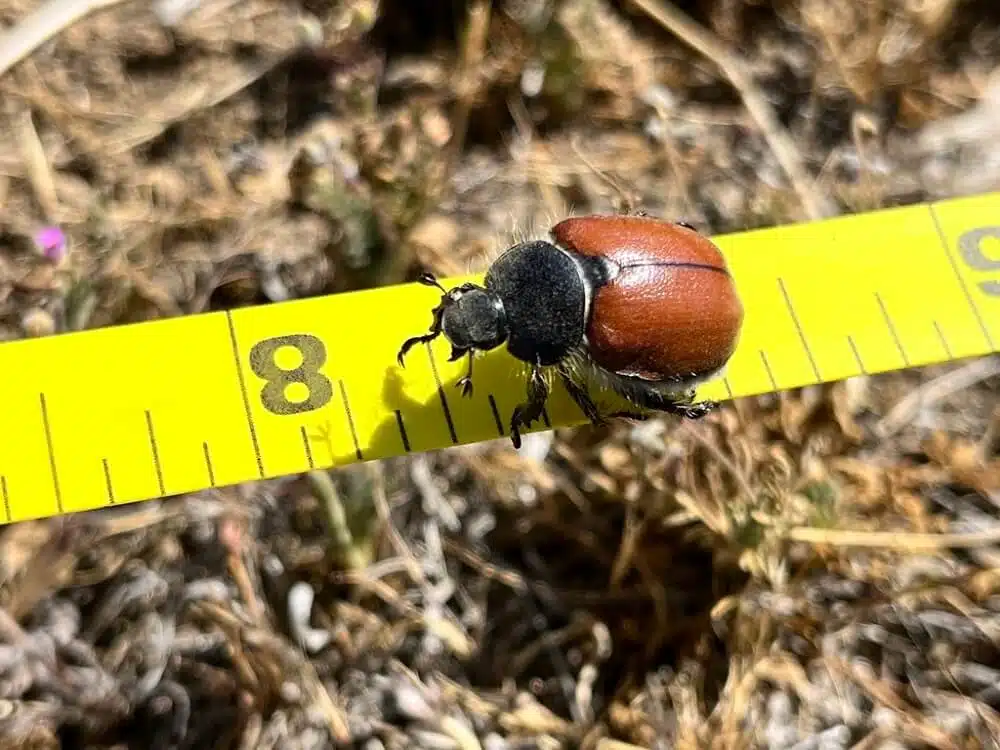
Feeding on leaves and flowers, Littler Bears (Paracotalpa ursina) are a type of dual color bug which may be dark orange or orange-brown.
While most bugs of The Little Bear genus have brown wings, there are a few populations with orange-brown coloring.
They are found in different types of legumes, flowers, and wildflowers.
Apart from the color of the elytra, they can also be identified by the metallic green cephalothorax and by their hairy ventral color.
Orange nuance – orange-brown
16. Locust Leaf-miner Beetle

Feeding on leaves, Locust Leaf-miner Beetles (Odontota dorsalis) also come in a mostly orange appearance.
These beetles may be orange and brown or orange or black, depending on their age or their location.
A bright orange or yellow-orange color of the wings is contrasted by brown or black stripes along the mid-dorsum.
The thorax of the species is uniform orange while its small head and antennae are black.
Locust Leaf-miner Beetle can be spotted feeding in the summer. Some of its typical hosts include oak and cherry.
In theory, Locust Leaf-miner Beetle outbreaks are possible every year. In reality, predators control their potential outbreaks.
Orange nuance – bright orange
17. Parenthesis Lady Beetle

Found in Canada and The United States, Parenthesis Lady Beetles (Hippodamia parenthesis) have a bright orange appearance.
Numerous shades of orange are specific to its elytra. These orange nuances are contrasted by black spots and fused black spots.
A black and white cephalothorax is specific to The Parenthesis Lady Beetles.
Crops, meadows, and grasslands are all part of its habitat. This species may be present in areas known for high aphid populations as predators.
These beetles spend their lives on the same plants where they feed on aphids and even lay eggs on these plants in their breeding period.
Orange nuance – yellow-orange, orange
18. Mexican Bean Beetle

The Mexican Bean Beetle (Epilachna varivestis) is native to Mexico but it also leaves along The Rocky Mountains.
A bright orange nuance is specific to its cephalothorax and elytra. Small black dots contrast its elytra.
These types of bugs are abundant in different types of bean crops.
Economic loss caused by The Mexican Bean Beetle can be severe. Simply non-chemical management solutions against the species may include planting beans a bit later in the season.
However, this isn’t a full-proof solution against these beetles as these bugs may even migrate for food.
Orange nuance – bright orange
19. Texas Soldier Beetle

The Texas Soldier Beetle (Chauliognathus scutellaris) is a species that lives in Texas, US Southern States, and in Mexico.
It has a contrasting appearance with either yellow and black or orange and black nuances dominating its wings.
Both the thorax and its wings show black central spots and orange margins while its head, legs, and antennae are all-black.
This species has an elongated shape and may often be spotted on yellow or orange flowers which act as camouflage.
Orange nuance – bright orange
20. Yellow-crescent Blister Beetle
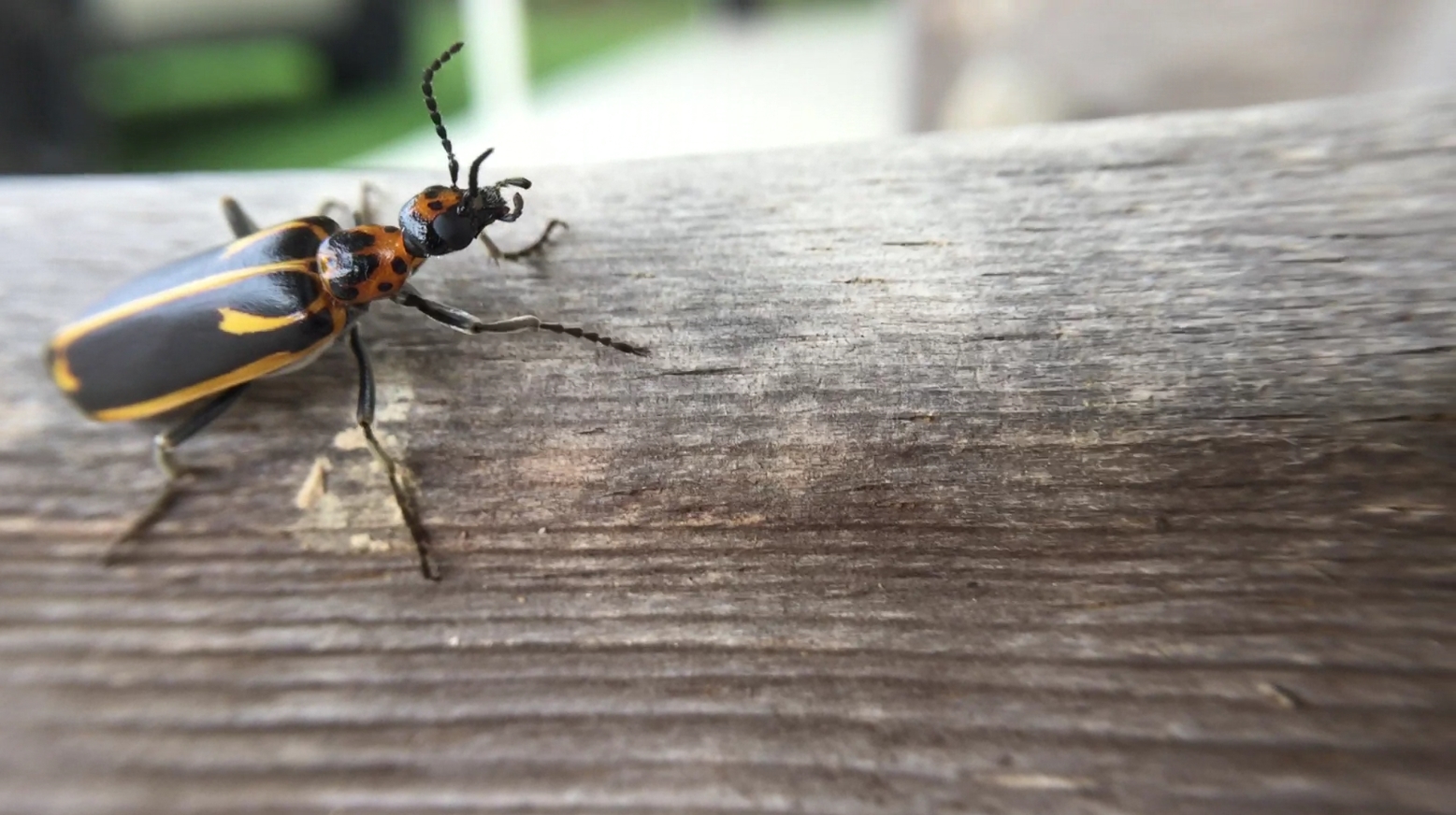
A similar black and orange appearance is specific to The Yellow-crescent Blister Beetle (Pyrota insulata).
Unlike The Texas Soldier Beetle, The Yellow-crescent Blister beetle is mostly black, with reduced orange sections across its wings.
This type of beetle is named after the skin reactions it causes when squeezed.
Yellow-crescent Blister Beetles are predators. They feed on the eggs of different species. Even more, these types of bees may become parasites, taking over underground bee nests.
Orange nuance – bright orange
21. California Lady Beetle
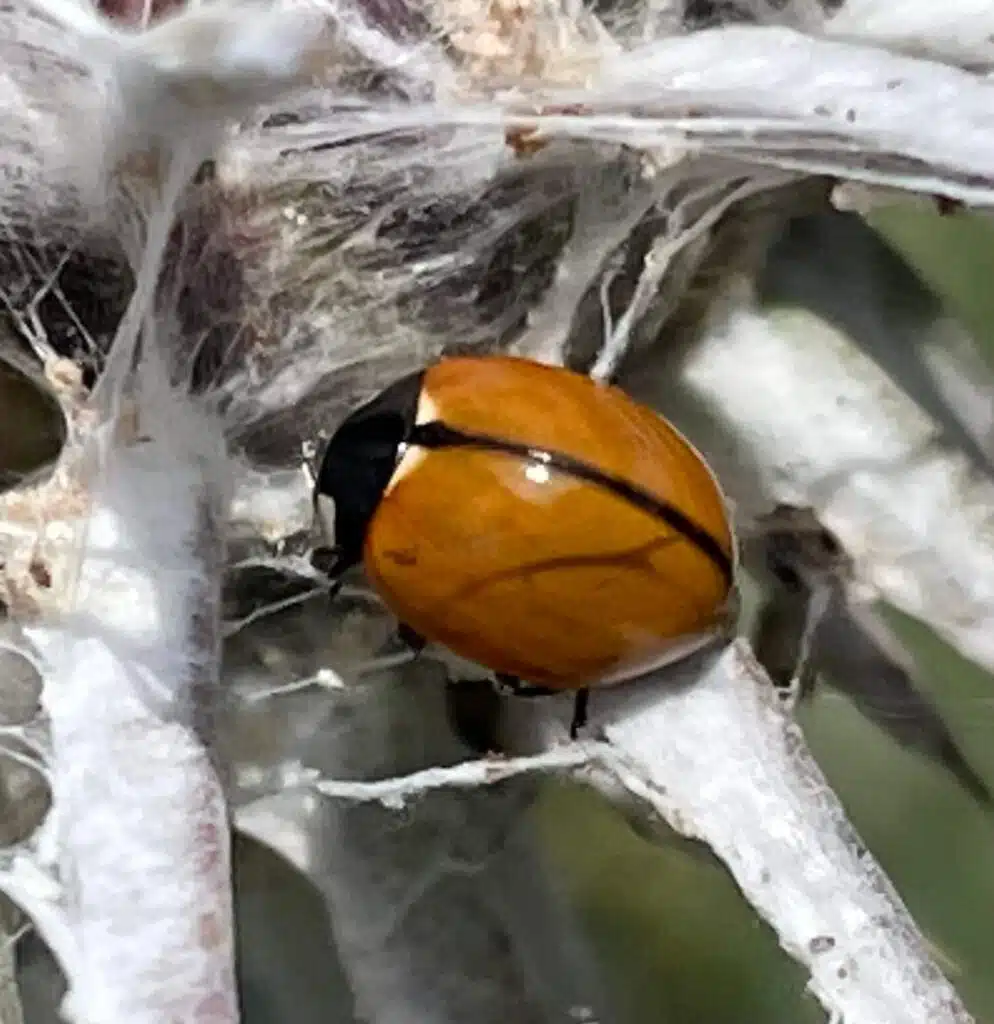
The deep orange coloring is specific to the unspotted California Lady Beetle (Coccinella californica).
A species of California, this beetle is mostly seen around the extended area of Los Angeles and has a growing presence on the West Coast.
Orange nuances are variable on the beetle. From bright to orange-brown, there are different nuances the species comes in.
It shows vivid coloring and rarely comes with small black spots but shows white marks at the base of the elytra.
Black and white marks are seen across its cephalothorax.
A species that feeds on plants, California Lady Beetles may prefer buttercups.
Orange nuance – orange-brown
22. Western Polished Lady Beetle

There are 3 main colors The Western Polished Lady Beetle (Cycloneda polita) comes in.
Orange, orange-brown, and red-brown are the main elytra nuances of the species. All of these nuances are coupled with a black-and-white cephalothorax.
Its orange morph has a bright nuance as adults and an almost all-black appearance as nymphs.
The nymphs of the species and the adults feed on true bugs and their eggs.
Its range expands from Western Canada to California.
Orange nuance – bright orange
23. Nine-spotted Lady Beetle

Black spots and vivid colors are specific to The Nine-spotted Lady Beetle (Coccinella novemnotata) throughout its life stages.
This is a species that is also known to be mostly yellow as a nymph, while many other lady beetle nymphs are black.
Black spots are seen on the bright nymphs and the orange adults.
Nine-spotted Lady Beetles were once the most important types of lady beetles that controlled agricultural pests in the Northeastern parts of the US.
Its numbers are now declining, mainly due to the introduction of non-native lady beetles to their habitat.
Orange nuance – bright orange
24. Spotted Asparagus Beetle

Some color variation is characteristic of The Spotted Asparagus Beetle (Crioceris duodecimpunctata).
This species is dominated by either orange or red colors, both contrasted by black dots, black eyes, and black antennae.
The main colors are uniform, covering the elytra and the thorax.
A species mostly found in Europe and Asia, the beetle feeds on asparagus. It is even considered a pest that requires serious management in some of its areas.
Nymphs and adults can eat the entire asparagus plant, especially its softer parts.
Orange nuance – bright orange
25. 13-Spotted Lady Beetle
Feeding on grasses and sedges, this species of orange bug (Hippodamia tredecimpunctata) has 13 large black spots across its elytra and thorax.
A bright orange color is contrasted by black spots of various shapes on the bug.
Its larvae are brown-black, with just a few faint orange spots.
13-Spotted Lady Beetles have a growing presence in Asia, Europe, and North America.
Orange nuance – vivid orange
26. Orange Blister Beetle
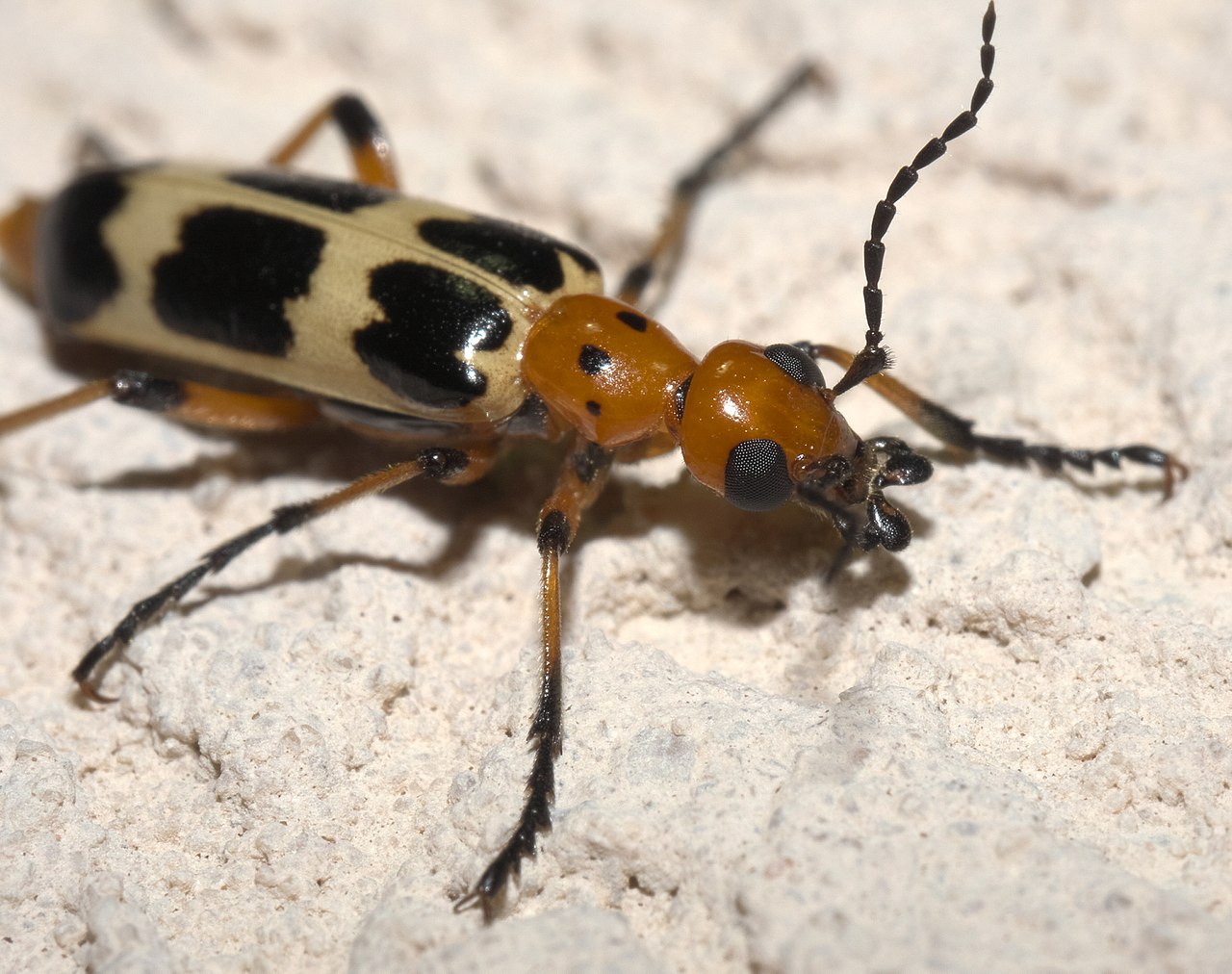
A nectar-eating species, The Orange Blister Beetle (Zonitis vittigera) feeds on various wildflowers in North America.
These beetles have an elongated body shape with a dark brown elytra that has 2 wide black bands.
Its head and thorax are also bright orange while its antennae are black.
Ingesting and producing toxins, Orange Blister Beetles are avoided by predators due to their unpalatable taste.
Orange nuance – orange-brown
27. Gigas Longhorn Beetle
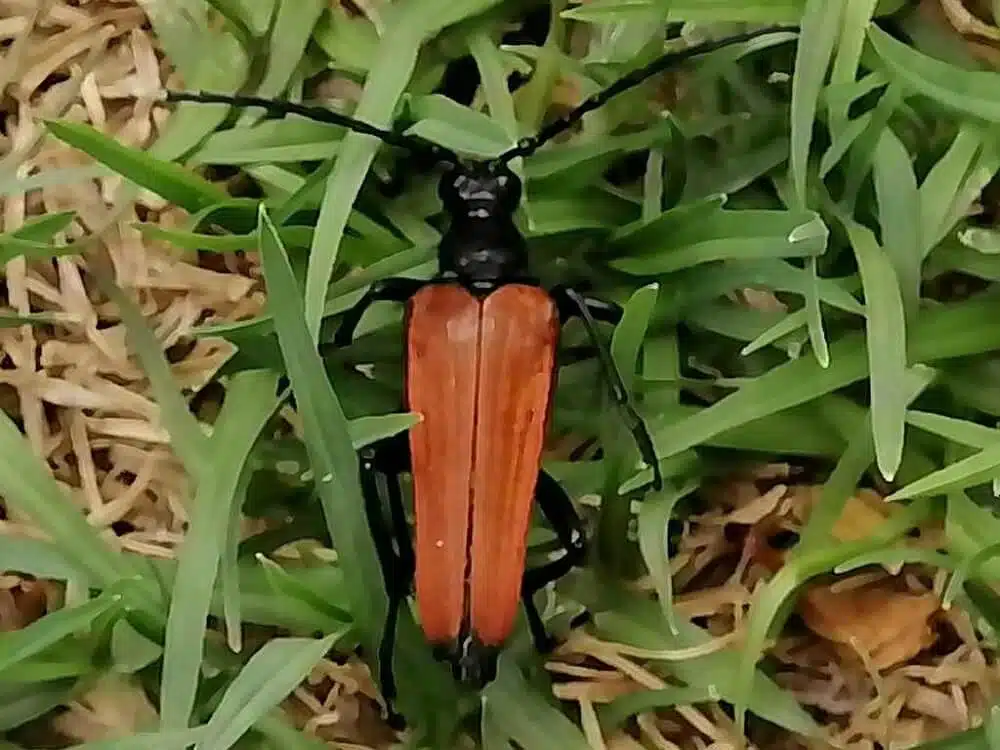
A predatory species also found in the Southern US states, Gigas Longhorn Beetles (Stenelytrana gigas) have orange wings and an elongated body shape.
Its wings taper towards the tips. The thorax and the head contrast its orange wings with black color.
Some color variation exists according to each region. Its wings can be orange or brown.
Gigas Longhorn Beetles are predatory bugs that are often found in areas with small soft pest bugs they feed on.
Orange nuance – bright orange
28. Arizona Net-winged Beetle

Mostly orange, The Arizona Net-winged Beetle (Lycus arizonensis) is spotted in the Southwestern areas of North America.
While spotted in states such as Arizona, this beetle is only found in the Southernmost regions of the state.
Slightly overlapping the Southern region of The Gigas Longhorn Beetle, Arizona New-winged Beetles are marked by their wide wings.
Orange wings that are wider towards the tips are specific to the species, unlike the narrowing wings of The Gigas Longhorn Beetle.
These bugs also have black wing tips while the head and thorax have a similar orange nuance.
Orange nuance – bright orange
29. Pleasing Fungus Beetle

Alternating black and orange bands are seen across The Pleasing Fungus Beetle (Megalodacne heros).
This is a species with a black head and 2 orange bands across its wings. A nocturnal feeder, Pleasing Fungus Beetles spend their lives under tree bark.
They may also liver under dead trees where they feed on the growing fungi on the wood.
Some of the dead trees that attract these types of beetles include oak and hemlock.
They do not cause any considerable damage to living trees as they only settle on trees that are already dead or that are about to die.
Orange nuance – bright orange
30. Spotted Diaperis

Golden orange, orange-brown, and brown colors are the main morphs of The Spotted Diaperis (Diaperis maculata). This species is further known for darkening with age.
There are 2 small black spots on the base of its elytra and 3 large joined spots on its slower elytra.
Black further dominates its cephalothorax.
Native to North America and Europe, the Spotted Diaperis is part of a wider group of darkling beetles, many dominated by black and orange colors.
Orange nuance – bright orange, gold orange